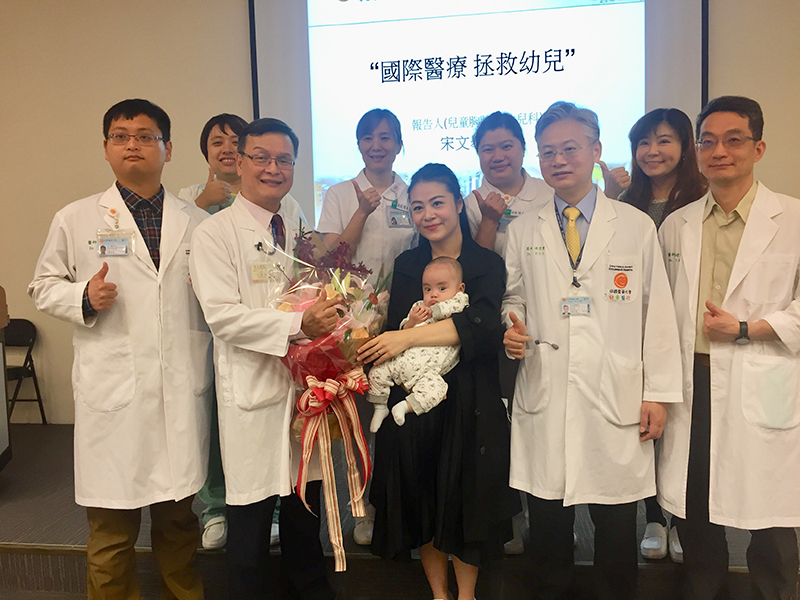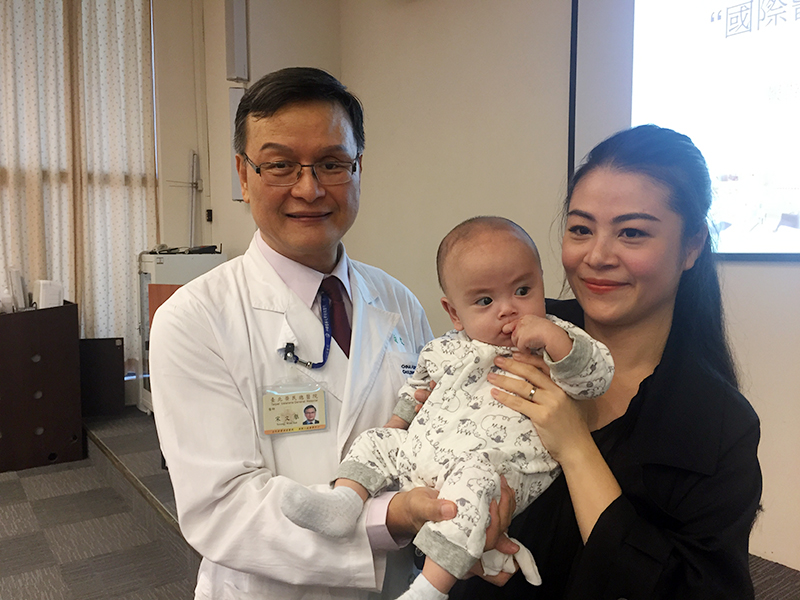News and Award
About CMUH
8-month-old Vietnamese Baby Boy Suffering from Critical Conditions in Severe Tracheal Stenosis Received Overseas Treatment and Returned Home Happily Children's Pulmonary and Critical Care Team treated him withfflexible bronchoscope and left only a small wound. Simple and Convenient

China Medical University Children's Hospital
Department of Pediatric Pulmonology Critical Care and Neonate Vice Superintendent Wen-Jue Soong
China Medical University Children's Hospital vice Superintendent Wen-Jue Soong led the “Pulmonary and Critical Care Team” and adopted the “flexible bronchoscope” to examine and treat many ill children suffering from innate airway abnormality, breathing difficulties, respiratory failure, requiring leave endotracheal intubation and respirator with remarkable effect. Soong has published multiple medical papers and he is internationally renowned. Recently, 8-month-old Vietnamese baby boy “An” suffered from severe tracheal stenosis, he could not receive proper treatment in the local area and was in critical condition. “An” has received medical treatment through the international medical transfer from China Medical University Children's Hospital and about to return home upon his successful treatment. The mother of “An” expressed: “We really appreciate Doctor Soong and his team for the attentive care on An so we could have a happy family again.”
An was born in Ho Chi Minh City, Vietnam, a 30-week premature baby with 1.4KG of weight at birth. He suffered from tracheobronchomalacia, collapsed left lung, repeated pneumonia and respiratory failure. He has received various examinations and treatment in three local children's hospitals in Vietnam without attaining any significant effect. His illness deteriorated increasingly and could only rely on endotracheal intubation and a respirator for living. However, the local hospitals could not improve his severe tracheal stenosis, putting him in critical condition and his life at stake.

Adopting flexible bronchoscope for balloon angioplasty. Stent placement cures tracheal stenosis while laser laryngoplasty cures laryngomalacia
Local Vietnamese doctors admitted the state-of-the-art medical technique of Doctor Wen-Jue Soong, so the local doctor contacted and verified for the treatment at CMUH. The medical teams from both sides exchanged and activated the international medical transfer mechanism if China Medical University Children's Hospital. Under the escort by the internal medical staff, An and hie parents flew to Taichung Airport from Ho Chi Minh City. China Medical University Children's Hospital appointed Pediatric Emergency Team Doctor Jie-Her Chen to the airport and escort the patient to Pediatric Critical Illness Ward for Treatment.
Doctor Wen-Jue Soong suggested that CMUH Pulmonary and Critical Care Team diagnosed An of severe stenosis in lower trachea (length 20mm) with caliber smaller than 3mm (normal size 8 to 10 mm) with “flexible bronchoscope” upon his arrival to CMUH. The team conducted angioplasty and has placed a metal stent (2 pieces/ 5x17 mm) with success to treat the symptoms of “tracheal stenosis.” The team also conducted laser laryngoplasty cures “laryngomalacia.” After the surgery, An immediately showed significant progress in breathing and eventually stopped endotracheal intubation and respirator. He could breathe naturally. He will be discharged from the hospital and return to Vietnam soon.
“We really appreciate Doctor Soong! He saved our life.” An's mother, Lai indicated that An could only breath with a respirator in Vietnam and could not recover from pneumonia infection. The local doctor mentioned that An would only be cured by dissecting the chest, using traditional surgery. She worried about the high risk in surgery and hesitated in receiving treatment at local hospitals. She waited for a long time before finding Doctor Wen-Jue Soong with his timely treatment in saving An's life. It took them some hardship before flying to Taiwan for treatment but everything was worth it.
The first Pediatric Bronchoscope Examination and Care Center in Taiwan. Flexible bronchoscope with small wound and does not require traditional surgery. Treatment for children with difficulties from Taiwan and abroad.
Doctor Wen-Jue Soong indicated that the Children's Flexible Bronchoscope Center” independently established on the 3rd floor of China Medical University Children's Hospital offers a variety of airway examination (Note 1) and care (Note 2). It is the first Pediatric Bronchoscope Examination and Care Center” in Taiwan and currently handles about 30 children with illness per month. Children with illnees are mostly difficult cases transferred from medical centers or hospitals. Doctor Wen-Jue Soong mentioned that the use of “flexible bronchoscope” has advantages in examination and treatment method: Small wound, no need for traditional surgery, and sometimes it can cure the diseases that could not otherwise be treated by operation. The treatment effect is excellent. For pediatric patients suffering from innate airway abnormalities, breathing difficulty, respiratory failure, and with long-term reliance or requirement of endotracheal intubation and respirator, flexible bronchoscope is the simplest, safest, precise diagnosis and effective treatment tool. The familiar operation of flexible bronchoscope for infant at critical illness condition can cure airway stenosis and improve the symptoms immediately, reduce the use of endotracheal intubation and respirator, avoid surgery with major injury, and save life, which merits promotion in application.
Note 1:Indications of Diagnosed Tracheoscopy
Strange and difficult breathing; chronic coughing, hemoptysis; suspicious obstruction in trachea; verification of endotracheal intubation and location of tracheotomy intubation; evaluation for the pulmonary damage of an inhalation injury; bronchoalveolar lavage; trachea and pulmonary tissue biopsy; persistent collapsed lung, pulmonary lesion; and infants with severe innate heart disease.
Note 2:Indications of Curative Tracheoscopy
Treatment for breathing difficulty (airway); supplementary endotracheal intubation; laryngomalacia; airway stenosis: glottis, endotracheal; removal of airway granulation; placement of tracheal stenosis; foreign object removal from airway; pneumorrhagia and atelectasis.



![[Taiwan–Malaysia Medical Innovation Forum] CMUH and UNIMAS Co-Host Major Medical Symposium to Advance Medical Technology and Precision Patient Care img](/FileUploads/News/20250714_131324.jpg?w=250&h=180&mode=crop&scale=both)